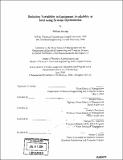| dc.contributor.advisor | Stephen Graves and Dimitris Bertsimas. | en_US |
| dc.contributor.author | Kwong, William W. M | en_US |
| dc.contributor.other | Leaders for Manufacturing Program. | en_US |
| dc.date.accessioned | 2006-11-08T16:33:46Z | |
| dc.date.available | 2006-11-08T16:33:46Z | |
| dc.date.copyright | 2004 | en_US |
| dc.date.issued | 2004 | en_US |
| dc.identifier.uri | http://hdl.handle.net/1721.1/34761 | |
| dc.description | Thesis (M.B.A.)--Massachusetts Institute of Technology, Sloan School of Management; and, (S.M.)--Massachusetts Institute of Technology, Dept. of Electrical Engineering and Computer Science; in conjunction with the Leaders for Manufacturing Program at MIT, 2004. | en_US |
| dc.description | Includes bibliographical references (leaf 62). | en_US |
| dc.description.abstract | Equipment management is an important driver behind operational efficiency, since capital equipment makes up about 40% of the average semiconductor manufacturer's total assets. The main goal of this project is to reduce variability in tool availability by planning for usage-driven preventive maintenance. A method and associated tools are proposed and investigated in the context of the Thin Films area in Intel's Hudson facility. The solution we propose incorporates the following characteristics: Drives towards a balanced preventive maintenance (PM) schedule such that PMs are evenly distributed in time; Enables fast recovery to a normal PM schedule after unexpected events occur on the factory floor, e.g. equipment breakdown, by re-distributing loads on each tool; Facilitates performance tracking and accountability; and Ensures consistency in the decision-making process. We will describe the conceptual method and the implementation process, from prototype deployment to the development of a production application. Alternative solutions using case-based reasoning and rule-based systems will also be discussed. We will conclude by discussing the role of automated decision systems in manufacturing and outline key issues to be considered in choosing an optimal design. | en_US |
| dc.description.statementofresponsibility | by William Kwong. | en_US |
| dc.format.extent | 69 leaves | en_US |
| dc.format.extent | 2578146 bytes | |
| dc.format.extent | 2583749 bytes | |
| dc.format.mimetype | application/pdf | |
| dc.format.mimetype | application/pdf | |
| dc.language.iso | eng | en_US |
| dc.publisher | Massachusetts Institute of Technology | en_US |
| dc.rights | M.I.T. theses are protected by copyright. They may be viewed from this source for any purpose, but reproduction or distribution in any format is prohibited without written permission. See provided URL for inquiries about permission. | en_US |
| dc.rights.uri | http://dspace.mit.edu/handle/1721.1/7582 | |
| dc.subject | Sloan School of Management. | en_US |
| dc.subject | Electrical Engineering and Computer Science. | en_US |
| dc.subject | Leaders for Manufacturing Program. | en_US |
| dc.title | Reducing variability in equipment availability at Intel using systems optimization | en_US |
| dc.type | Thesis | en_US |
| dc.description.degree | S.M. | en_US |
| dc.description.degree | M.B.A. | en_US |
| dc.contributor.department | Leaders for Manufacturing Program at MIT | en_US |
| dc.contributor.department | Massachusetts Institute of Technology. Department of Electrical Engineering and Computer Science | |
| dc.contributor.department | Sloan School of Management | |
| dc.identifier.oclc | 56714339 | en_US |
